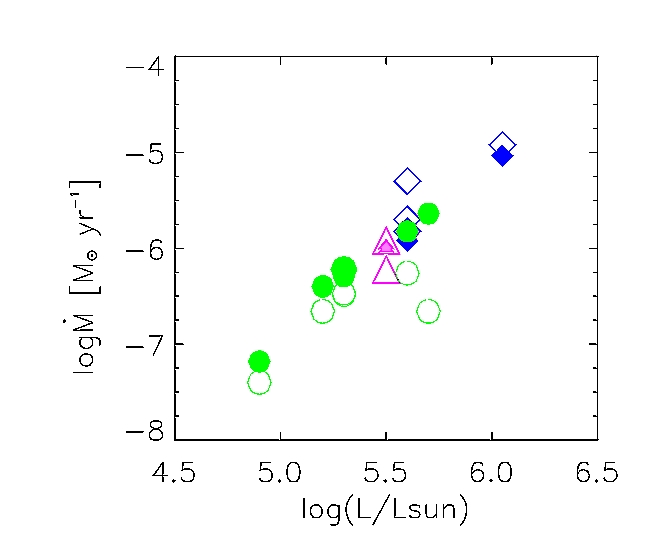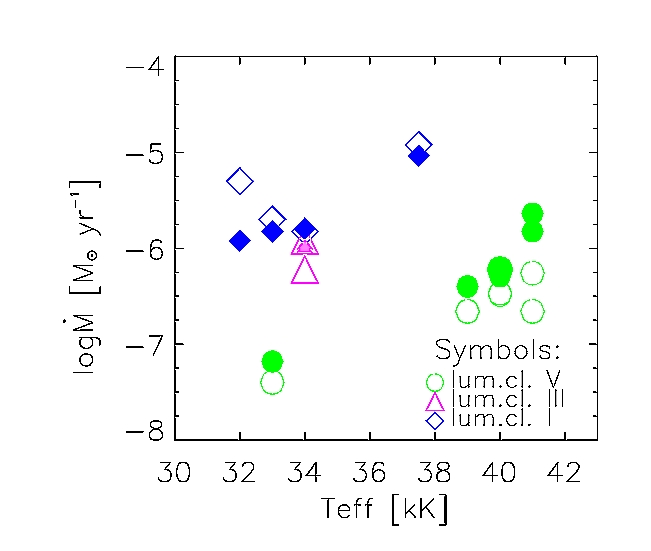JOBS !!
Post-doctoral position
Graduate student position
Massive Stars in Local Group galaxies:
 Revising the Temperature Scale of Massive stars
Revising the Temperature Scale of Massive stars
Go to the FUSE Science Summary Press Release
 Lea un comunicado de prensa en Español
Lea un comunicado de prensa en Español
Press release from HST data
Caption The values of Teff and Lbol derived by our consistent analysis
of wind and photospheric features for a sample of thirteen Galactic O-type stars (symbols
denote different luminosity classes), and for an O6-type star in M33 (filled star),
are compared to previous calibrations
(Vacca et al. 1996, dashed line, and de Jager & Nieuwenhuijzen 1987, solid line).
Results for the mid-O type stars are from
Bianchi & Garcia (2002a), and for the early types from Garcia & Bianchi (2004)
Caption Mass loss rates derived from our
consistent modeling of the spectra (hollow symbols)
are compared to values predicted by the radiation pressure wind theory
(filled symbols) using the recipe of Vink et al. (2000). They are shown
as function of luminosity (left) or Teff (right).
There is agreement for most supergiants, while our
values for dwarf stars are systematically lower than the predictions.
Here is the main story :
Bianchi et al. 2003, and Bianchi and Garcia 2002 found that the temperatures of
early type stars are up to
20% cooler than previously believed. The finding is based on a consistent modeling of
far-UV (FUSE) and UV (IUE, HST, ORPHEUS) spectra with line-blanketed, hydrodynamic, non-LTE,
spherical synthetic stellar models.
The significant revision has enormous implications for:
-> stellar evolution: if stars are cooler than we thought by 5-20%, their
luminosities will be significanlty (20-80%) lower.
If temperature and luminosity of the massive stars are lower than we thought,
their masses are lower too, thus they evolve on longer time scales.
-> evolution of galaxies and the universe hot massive stars are responsible
for transforming the primordial elements (hydrogen and helium)
into the heavy elements which sustain life, and which become the constituents of new stars and
planets. Time-scales and entity of this process depend on the stellar masses.
Thus a revision of fundamental parameters of massive stars must be taken
into account when we try to understand the overall chemical
enrichment and evolution of galaxies.
-> Ionization of the interstellar medium with their strong supersonic winds,
and high UV luminosities,
hot massive stars drive the ionization and dynamics of the surrounding medium, regulating
the subsequent formation of less massive stars. The ionizating photons,
mostly below the Lyman
limit, can only be inferred from temperature and luminosity measured from data at longer
wavelentghs.
-> probing more distant galaxies
Hot stars are very luminous (up to a million times more luminous than our Sun), thus
can be observed in galaxies outside our own Milky Way, with different conditions and star
formation histories (see sample papers below).
Get Publications and Preprints:
Back to home page
 Revising the Temperature Scale of Massive stars
Revising the Temperature Scale of Massive stars  Revising the Temperature Scale of Massive stars
Revising the Temperature Scale of Massive stars 

